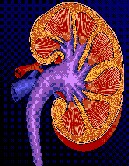Limited effect among adult patients during five years following kidney transplantation
FRIDAY, June 25, 2015 (HealthDay News) — For kidney transplant recipients, steroid avoidance has limited impact for reducing new-onset diabetes after transplantation (NODAT), according to a study published in the July issue of the American Journal of Transplantation.
John D. Pirsch, M.D., from the University of Wisconsin in Madison, and colleagues examined whether steroid avoidance reduces the NODAT risk following kidney transplantation. Data were included from a five-year early steroid withdrawal double-blind randomized trial. Using eight definitions, the incidence, timing, and risk factors for NODAT were assessed.
The researchers found that by five years, 36.3 percent of patients on chronic corticosteroids (CCS) and 35.9 percent on early corticosteroid withdrawal (CSWD) were diagnosed with NODAT by the American Diabetes Association definition. Slightly more cases of NODAT were identified with the definition combining fasting blood glucose ≥126 mg/dL on two occasions or treatment (CCS, 39.3 percent and CSWD, 39.4 percent). The proportion of NODAT patients requiring treatment through five years posttransplant was similar (CSWD, 22.5 percent and CCS, 21.5 percent); insulin therapy was lower with CSWD than CCS (3.7 versus 11.6 percent; P = 0.049). Only age was a significant risk factor for NODAT for more than one definition in multivariate analysis.
“This prospective, randomized trial of CSWD indicates that CSWD has a limited impact in reducing NODAT when compared to low-dose prednisone (5 mg/day from month six to five years),” the authors write.
Several authors are employees of Astellas Pharma Global Development and Astellas Scientific and Medical Affairs.
Copyright © 2015 HealthDay. All rights reserved.








